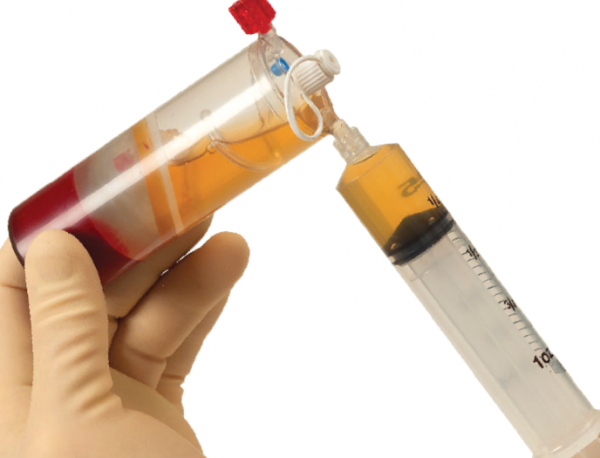Growth factors are proteins that stimulate cell proliferation and cell differentiation. Platelets or thrombocytes, produced in the bone marrow, release numerous platelet growth factors (PDGF, TGF β, VEGF, IGF-1, FGF and EGF) able to mediate the healing of damaged tissues, modulate inflammation and stimulate the formation of new blood vessels. The granules contained in platelets are also rich in cytokines, chemokines and other proteins that stimulate cell proliferation and cell maturation, promoting the tissue regeneration process.
It is therefore possible to benefit from this natural function associated with growth factors to treat degenerative orthopaedic conditions and lesions of the cartilage or tendon. To this end, a plasma with a high concentration of platelets is used, known as PRP or Platelet Rich Plasma. PRP has a 95% concentration of platelets and is injected into the region to be treated in order to stimulate tissue repair and reduce inflammation. Growth factors must be injected into a tissue rich in vascularisation, from where they can spread and circulate to play their role that sees the recall and modulation of the cells subject to healing.
In Aesthetic Medicine, platelet growth factors are used to reduce the signs of aging by stimulating the cutaneous regeneration that decreases progressively with age. In fact, over the years our skin loses its tone, shine and brightness. Growth factors are able to stimulate the production of collagen and improve blood flow, preventing and delaying the aging process. The therapy is therefore recommended for the prevention and treatment of aging skin and tissue damage due to photoaging. Once injected into the face or body, growth factors trigger a process of repair, regeneration and therefore rejuvenation of the skin. The restructuring of the dermis and the improvement of elasticity contribute in a decisive manner to a bright, healthy and young skin appearance.
Platelet growth factors: procedures
The preparation of PRP consists of an autologous venous blood sample collection (in other words from the patient themselves), similar to that of a normal blood test. After collection, the blood undergoes centrifugation and cell separation in order to obtain a gel with a high concentration of platelets. Four to ten test tubes of platelet concentrate are prepared from the blood sample drawn. The PRP tubes can be stored at a low temperature and used as needed for the infiltrations.
The treatment with platelet growth factors is therefore a very safe procedure, as the blood is drawn from the same patient on which it will be used and there is no risk of contracting communicable diseases. An orthopaedic specialist’s evaluation is nonetheless needed to ensure patient suitability for the treatment.
In orthopaedics, PRP therapy is used to treat the following conditions:
– ligament and tendon lesions (shoulder, knee, ankle). For example partial lesions and tendonitis of the rotator cuff, the Achilles tendon or the patellar tendon;
– chronic tendonitis;
– cartilage lesions;
– muscle lesions;
– osteoarthritis of low/medium severity;
– epicondylitis/epitrocleitis.
Moreover, the infiltrations can be made during arthroscopic surgery to help speed up the healing process and reduce inflammation.
In aesthetic medicine, PRP therapy is used in:
– the treatment of wrinkles
– the treatment of poor skin tone
– treatment of cutaneous tropism
– the treatment of premature hair loss
Bio-stimulating and regenerative therapy with PRP is completely natural and is not associated with any contraindications as the therapy is based on the exclusive use of the patient’s own blood. There is no risk of allergies or other types of reaction to the patient, as long as the treatment is performed in appropriate facilities and by specialist doctors.
Treatment with growth factors is contraindicated in cases of pathologies which may change the patient’s blood profile (such as platelet deficiency, systemic neoplasms and acute infectious diseases). In the six days prior to receiving the treatment the patient may not use anti-inflammatory drugs, cortisone and antibiotics.

